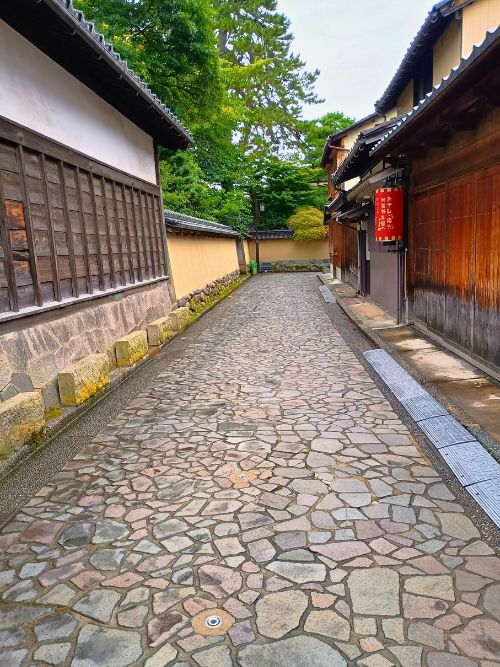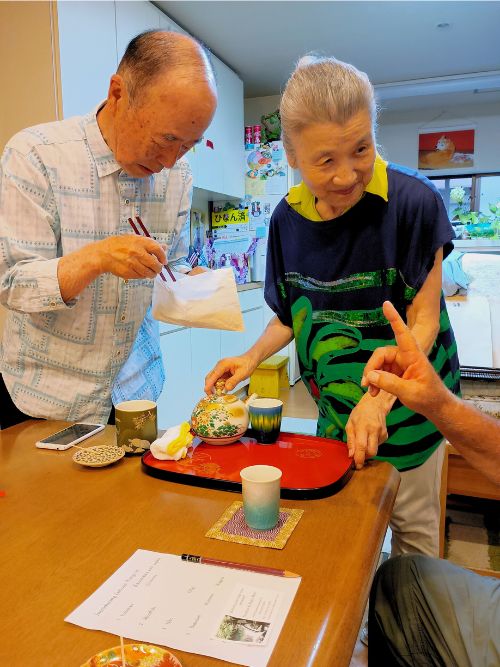
Go World Travel is reader-supported and may earn a commission from purchases made through links in this piece.
We boarded the sleek Shinkansen (Bullet Train) at Tokyo Station for the three-hour, sail over the rails at 160 mph, to Kanazawa. Until I booked my coast-to-coast excursion of Japan, I had never heard of this unique, intimate city of 465,000 inhabitants.
It wears so many labels, Jewel of Japan, UNESCO City of Crafts and Folk Art, Castle Town, and Living World Heritage communities, that Kanazawa deserves increased exposure in the travel world.
Disembarking at Kanazawa Station, chosen as one of the world’s 14 most beautiful railway depots, we gazed up at an architectural marvel upon exiting the building. A contemporary, glass dome called Motenashi designed like an umbrella, protects visitors from frequent rain and snow.
Attached to the dome, a massive, wooden structure, Tsuzumi-mon Gate, rises at the East entrance, and evokes the image of centuries-old tsuzumi drums. This intertwining of 430 years of tradition alongside its vibrant present puts Kanazawa on the ‘must see’ list.
Epicenter of Traditional Japanese Crafts

Kanazawa, which miraculously escaped damage from all wars and disasters for over 400 years, retains the unique cultural elements of its history. The Maeda Clan, who took over in 1583, wanted to reassure the ruling Shogun that they were not a political threat. They invited prominent artisans from around Japan to establish cultural arts and crafts for the people, to a level rarely seen in other parts of the country.
Today, Kanazawa, known as the City of Kogei or crafts, remains the epicenter of gold leaf application, washi paper making, tea ceremonies, and masterful pottery art.
Kanazawa Castle Par and Kenrokuen Garden

We started our exploration at Kanazawa Castle, within walking distance of our hotel, Tokyu Stay Kanazawa. As the ruling seat of the Maeda Clan during the 17th Century, the Castle suffered damage from fire, but now is being restored and the grounds, designated as a ‘Place of Scenic Beauty’ doubles as a public park.
We roamed throughout the beautiful arrangement of ponds and stone walls, climbed to the top for an overview of the area and marveled at the extent of garden vegetation within a cosmopolitan city.
Planning a last-minute trip to Japan?
Top Experiences and Tours in Japan:
- See the sights with a tour of Tokyo: Full-Day Private Tour with Nationally-Licensed Guide
- See Mount Fuji on the Private Full Day Sightseeing Tour to Mount Fuji and Hakone
- Explore more with this tour of Tokyo Half-Day Private Tour with Government-Licensed Guide
Where to stay in Japan:
- Find accommodation with Booking.com
- Find your dream apartment in Japan with Agoda
- Find a hostel in Japan with Hostelworld
Situated next to Kanazawa Castle, lies one of the three most beautiful gardens in Japan, Kenrokuen Garden, founded during the Edo Period (1603-1868) by the Maeda for their private use.
The garden’s name means ‘arrangement of six facets,’ attributes reflected in most Japanese gardens: spaciousness, tranquility, artifice, antiquity, abundant water and magnificent views. This area of stunning splendor offers spring’s cherry blossoms, summer’s vibrant greens, fall’s colorful foliage and winter’s snowy wonderland.
Read More: Exploring Tokyo: A Local Expert’s Guide to Must-See Spots and Hidden Gems
3. Nagamachi Samurai District

At the edge of Kanazawa Castle’s gate, lies the historic Nagamachi Samurai District, where middle-class samurai families lived during the Edo Period. Strolling down the mostly deserted, narrow, cobblestone streets of this historic area, we could feel the presence of samurai warriors’ homes with earthen walls, private entrance gates and water canals running alongside the residences.
The peacefulness belied the fact that a bustling main thoroughfare laid only steps away. We visited the Nomura-ke museum, a restored samurai house, displaying lifestyle and artifacts during the prosperous samurai era.
Higashi Chaya District

Having previously interacted with a retired matron and a young, working Geisha during a learning and discovery activity, we were excited to explore the Higashi Chaya (meaning teahouse) District. It is one of three traditional towns in Kanazawa, dedicated to past and present geisha teahouses.
For over 200 years, these traditional, wooden chaya that line the streets served as venues where Geisha entertained nobility and rich merchants. Today, although mostly exclusive performances, casual music, dance, and tea ceremony events staged throughout the year can be enjoyed by visitors. A hush fell, as two beautifully costumed, and coiffed geishas passed by on their way to their profession of providing classic, Japanese entertainment.
Read More: Japanese Onsen Public Hot-Spring Etiquette
Learning the Crafts – Gold Leaf Application, Washi-Paper Making and Mochi Rice Prep

Privileged to experience hands-on instruction of three of Kanazawa’s historic, traditional crafts, we learned the intricacies and extensive care given to the artistries produced here. We visited the Hakuichi factory where the arduous task of reducing gold bars down to razor thin sheets of gold leaf unfolded.
We were each given two small squares of gold leaf, to make postcards with our dubious, artistic magic, to send off to friends and family. Gold leaf is such a popular application in Japan that you can buy gold leaf golf balls or eat ice cream dipped in gleaming gold flecks.
The fascinating task of making Japanese washi-paper used for wall hangings, stationery, wallets, and purses – astounded me at Washi-no-Sato factory. The intense process of 12 steps goes back 1200 years and transforms Kozo mulberry plant fibers into the finished paper product.
Dunking rectangle boards into the processed liquid, shaking off the excess paste, allowing the wet paper to dry, and then making cards for our personal use made me laugh, such fun and so amazing.
The work became a little more strenuous when we went to the Mochi Sticky Rice Cake education center in Gokayama Region. White rice must be pounded, by hand, with a huge, wooden mallet until the mound is reduced into a ball of mashed sticky rice or mochi, a Japanese festival food. We not only pounded the rice, but then enjoyed eating our creation.
Ainokura Village/Gokayama Region

The van climbed up into the Japanese Alps toward Ainokura Gassho-zukuri village in Toyama Prefecture. Considered a Japanese original landscape, this is the largest and most remote Gassho-style village with 20 houses. Gassho refers to cottages that are constructed with thick, triangular shaped, thatched roofs, woven to withstand heavy winter snows.
The roofs must be replaced every 40 years and the people who live there all pitch in to help one another rebuild these durable roofs. The village has been designated as both a World Cultural and Living World Heritage site, because people actually reside and work there.
Visitors can climb a mountain trail to view the entire village from above, but we chose to walk among these unique structures, breathe in the clean mountain air, and watch the butterflies dance in the small fields of wildflowers.
We visited the Ainokura Jinushi Shinto Shrine, nestled between tall pines, threw in a few yen coins and said a prayer for the safety of the villagers, as winter was fast approaching.
Read More: Exploring Tokyo: A Local Expert’s Guide to Must-See Spots and Hidden Gems
Izakaya Nights
After days of touring, find the closest Izakaya, pub-like bars that serve up ice cold draft beers and skewered snacks. Kanazawa has hundreds of them hidden away in alleys, on second floor hide-outs or basement restaurant malls.
We found a different one every evening. They are fun, and lively. Snacks of satay beef, chicken, livers, anything you can think of that can be broiled on a skewer make a delicious combo with mugs of draft Kirin. Enjoy modern Kanazawa at night.
Special Home Visit

Our last memory of Kanazawa turned out to be the most special. I, my husband, son, and daughter-in-law were honored to be invited into the home of a retired, junior high school principal and his talented wife, Naohiro and Reiko Mori. We removed our wet shoes from the rain, placing them on absorbent paper in the genkan area, before we entered the main house.
Their home felt comfortable and welcoming. Traditional Japanese cultural items filled the space with tea sets, a miniature Shinto Shrine, and a polished, wooden Koto or Japanese Harp, waiting to be played. The endearing couple, eager to introduce Japanese customs to their guests, had an organized list of activities prepared.
After showing family photos, they offered us green tea speckled with flakes of gold leaf and yohukan, red bean paste wafers. Origami and calligraphy lessons proceeded as Naohiro and Reiko gently helped us make whooping cranes, symbols of long-life, with washi paper and to print our names with Japanese characters in calligraphy style.
Through a mixture of English, Japanese and gestures, Naohiro explained that he and Reiko pray every morning at the Shrine. Reiko shyly admitted the Koto had been handed down from her mother, as she knelt beside the national instrument and played and sang delicate cherry blossom songs.
The fun began when the couple dressed each one of us in silk kimonos, obi sashes, and added Japanese ohgi, fans, and wagasa, parasols. For a few moments, we felt Japanese. The time spent with these proud, generous people, willing to share their home and their customs with strangers, remained a lasting impression for me, of all things Kanazawan.
Read More:
Author Bio: After a life-long profession of treating the mentally ill at a PA psychiatric hospital for 33 years, Carol retired to Lake Chapala, Mexico in 2006 with her husband, to pursue more positive passions. Her family thought that she too had ‘gone mad.’ Carol has taught English to Mexican adults and disadvantaged local children for the past 18 years. She writes for local, international, on-line and print publications. Using her adventures to over 120 countries, she has captured a niche in travel writing, and her stories have been featured in Go World Travel Magazine. A frequent contributor to El Ojo del Lago, the largest distribution English magazine in Mexico, she’s won several literary awards from that publication. Her psychiatric field work netted a contribution to the anthology, Tales from the Couch. Recently she has also been featured in two more anthologies, Insider’s Guide to the Best of Mexican Holidays, and Bravados, Life, Love and Living in Lake Chapala, Mexico, all available on amazon.com.
- Discover Claremont, California Along Historic Route 66 - December 6, 2024
- Three Sites to Soothe the Soul in Kyoto, Japan - December 5, 2024
- 13 Essential Tips For Women Traveling in Morocco - December 4, 2024


